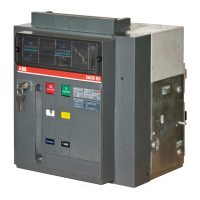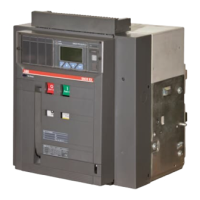N° Doc.
Doc. No.
Mod.
Rev.
M4379
SACE Emax
601933/003
Aparato
Apparatus
Escala
Scale
N° Pag.
Sh. No.
54/100
I1 = 0.5 x In t1 = Curva /
Curve
“C”
I1
Valor teórico I/In /
Theoretical /In value
= 925 / 2000 = 0.4625
El valor práctico que se debe programar es I1 /
The practical value to set is
I1 = 0.5
Is = (5 x I) / (I1 x In) = (5 x 925) / (0.5 x 2000 ) = 4.625
Curva /
Curve
A: I²t = 6I1 x 6I1 x 3 = 108 I1²
Curva /
Curve
B: I²t = 6I1 x 6I1 x 6 = 216I1²
Curva /
Curve
C: I²t = 6I1 x 6I1 x 12 = 432 I1²
Curva /
Curve
D: I²t = 6I1 x 6I1 x 18 = 648I1²
Curva/
Curve
a) Se calcula la relación entre la corriente de circulación y la corriente
nominal del TA que define la fracción de In teórica:
b) Se calcula (Is) la relación entre la corriente de sobrecarga y el valor de
corriente I1 programado que define el múltiplo de I1:
c) Sucesivamente, es necesario buscar la curva dentro de la cual, con
una sobrecarga de 4.625 x I1, el tiempo de actuación no supere los
25s.
Utilizando la fórmula I²t = Cost se calculan los valores de las
constantes de las curvas A, B, C y D (véase párrafo 12.8):
a) The relationship between the circulating current and the rated current
of the CT is calculated, which defines the fraction of theoretical:
b) The relationship (Is) between the overload current and the current
value I1 set, which defines the multiple of I1:
c) It is now necessary to look for the curve within which, with an overload
of 4.625 x I1, the trip time is not longer than 25s.
Using the I²t relationship = Const, we calculate the values of the
constants of the curves A, B, C and D (see para. 12.8):
Now we calculate the real trip time according to the selected curve:
Luego, se calcula el tiempo real de actuación en función de la curva
seleccionada:
De esta manera se deduce que la curva que se debe programar es la
“C “ya que es la que mejor cumple con los requisitos. La programación
será la siguiente:
The curve to be set is definitely the “C” one as it best fulfils our
requirements. The protection setting will therefore be as follows:
Curva /
Curve
A: t1 = 108 I1² / (IsI1 x IsI1 ) = 108 /(4.625 x 4.625) = 5.0 s
Curva /
Curve
B: t1 = 216I1² / (IsI1 x IsI1 ) = 216 /(4.625 x 4.625) = 10.1s
Curva /
Curve
C: t1 = 432 I1² / (IsI1 x IsI1 ) = 432/(4.625 x 4.625) = 20.2s
Curva /
Curve
D: t1 = 648I1² / (IsI1 x IsI1 ) = 648/(4.625 x 4.625) = 30.3s
Curva A ⇒ tiempo de actuación 3s a 6 x In
Curve A
⇒
trip time 3s at 6 x I1
Curva B ⇒ tiempo de actuación 6s a 6 x I1
Curve B
⇒
trip time 6s at 6 x I1
Curva C ⇒ tiempo de actuación 12s a 6 x I1
Curve C
⇒
trip time 12s at 6 x I1
Curva D ⇒ tiempo de actuación 18s a 6 x I1
Curve D
⇒
trip time 18s at 6 x I1
Curva/
Curve
A
Curva/
Curve
B
Curva/
Curve
C
Curva/
Curve
D
12.3.1.2 Selection of the trip curve (t1)
4 different trip curves can be selected by using the dip-switches indicated
in fig. 48 ref. R.
These curves are defined by the function I²t = defined Const (*) of the
values:
The trip time tolerance is ± 10% up to 2 x In and ± 20% over 2 x In.
(*) The minimum value of this trip is 750 ms regardless of the type of curve
set (self-protection).
The table below shows the possible settings:
La tolerancia en los tiempos de actuación es ± 10% hasta 2 x In y ± 20%
para más de 2 x In.
(*) El valor mínimo de dicha actuación es de 750ms independiente del
tipo de curva programada (autoprotección).
En la siguiente tabla se indican las programaciones posibles:
12.3.1.2 Selección de la curva de actuación (t1)
Se pueden seleccionar 4 curvas de actuación diferentes configurando los
dip-switch indicados en la fig. 48 ref. R .
Dichas curvas se definen mediante la función I²t = Cost (*) determinada
por los valores:
12.3.1.3. Ejemplo de programación
A continuación se ilustra un ejemplo de programación de la protección
a tiempo largo inverso (L).
Se desea efectuar una protección con las siguientes características:
Un interruptor SACE Emax con TA de 2000A y una corriente nominal
de circulación de 925A.
Se desea proteger la carga de esta manera:
– en un tiempo de 25s con una sobrecarga 5 veces superior a la corriente
de circulación.
12.3.1.3 Example of setting
An example of inverse long time-delay (L) setting of the protection is
given.
A protection with the following characteristics is to be made:
A SACE Emax circuit-breaker mounts 2000A CTs and the circulating
service current is 925A.
The load is to be protected as follows:
– within a time of 25s with an overload 5 times the circulating current

